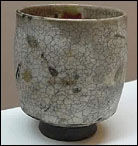
 Hiroshi Kôjitani (Nara, Japan, b. 1937) White as White Can Be (haku, haku), 1996 Matching set of utensils (kaigu): water jar (mizusashi), ladle stand (shakutate), waste-water receptacle (kensui), kettle-lid rest (futaoki) Glass |
Sen Rikyû (1522–1591) is said to have mentioned, “suki (style, aesthetic) in chanoyu is not copying others.” Firmly establishing in the tea aesthetic his own style based on severity, austerity, and melancholy, he introduced the most avant-garde period in the history of chanoyu by commissioning his own designs of tea utensils rather than using the Chinese wares that had been the most prized utensils. The creation of new types of utensils proclaimed the beginning of a new way of tea.
Such an innovative spirit developed out of the Zen-based credo of “living in the present.” Inheriting this spirit, Rikyû’s disciple Furuta Oribe formed his own way of tea with his utensil designs, their freely-expressed artfulness contrasting with Rikyû’s preference for reserved simplicity. Within the span of half a century, chanoyu produced such distinct masters whose contributions to later developments in tea utensils are immeasurable.
Today, four centuries later, individualism remains the pursuit of artists working toward the attainment of their own expressive language. While the materials used are as diverse as clay, glass, acrylic, bamboo and brass, the contemporary artists featured in the present exhibition align themselves with the lineage of the avant-garde.
Collaboration
During the tea gathering, however, individualism expressed through unique designs in utensils corresponds with a certain thematic tone, seasonal or otherwise, to encourage a holistic experience of the moment. The collaborative nature of the utensils assembled for the tea gathering parallels an orchestral composition. In this analogy, the tea utensils are the members of an orchestra rather than soloists. The host, then, is the conductor who leads them to resonate with each other. As if listening to a symphony, the guest follows the main theme while enjoying the distinct functionality and visual appeal that each utensil embodies.
Most of the tea utensils on display have been used in actual tea gatherings where contemporary artists and craftspeople participated in this symphonic form of art, sometimes as hosts, other times as guests. The aim of showcasing the utensils as well as the tearooms in this exhibition is to encourage the viewers to mindfully conduct their own collaborative symphony, that is, chanoyu.
Copyright © 2002 Asia Society

Isak Isaksson (Sweden, 1949)
The Broken Earth, 2001
Teabowl (chawan)
Stoneware

Yasuhiro Kiyomizu (Japan, b. 1957)
Play, Bravery, Transcendence (yû, yû, yû), 2000
Teascoops (chashaku)
Aluminum

Hiroshi Awatsuji (Japan, 1925-1995)
Crescent, Adornment, Tab (gen, sô, kan), 1992
Teascoops (chashaku)
Bamboo

Kimiko Nakamura (Kyoto, Japan, b. 1962)
Untitled, 1992
Matching set of utensils (kaigu): water jar (mizusashi), ladle stand (shakutate), waste-water receptacle (kensui), kettle-lid rest (futaoki)
Stainless steel